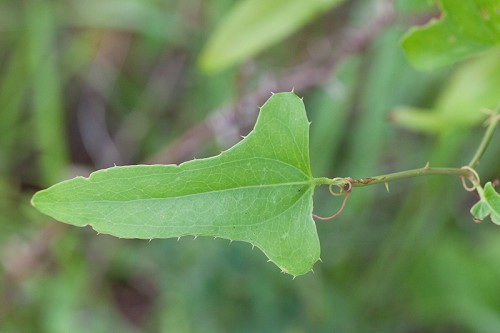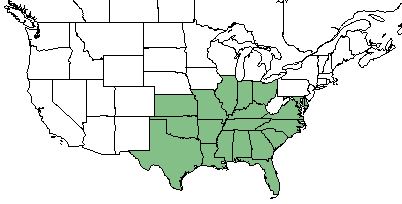Difference between revisions of "Smilax bona-nox"
(→Ecology) |
|||
| Line 33: | Line 33: | ||
===Habitat=== | ===Habitat=== | ||
Common habitats for ''S. bona-nox'' include wetland and upland habitats, dunes, and maritime thickets and forests. <ref name= "Weakley"> Weakley, A. S. (2015). Flora of the Southern and Mid-Atlantic States. Chapel Hill, NC, University of North Carolina Herbarium.</ref> | Common habitats for ''S. bona-nox'' include wetland and upland habitats, dunes, and maritime thickets and forests. <ref name= "Weakley"> Weakley, A. S. (2015). Flora of the Southern and Mid-Atlantic States. Chapel Hill, NC, University of North Carolina Herbarium.</ref> | ||
| − | |||
''S. bona-nox'' can grow in a variety of soils, coarse, medium, and fine textures.<ref name= "USDA"> [https://plants.usda.gov/core/profile?symbol=CEAM USDA Plant Database]</ref> | ''S. bona-nox'' can grow in a variety of soils, coarse, medium, and fine textures.<ref name= "USDA"> [https://plants.usda.gov/core/profile?symbol=CEAM USDA Plant Database]</ref> | ||
| − | |||
It has a medium tolerance to drought and a high tolerance for shade. <ref name= "USDA"> [https://plants.usda.gov/core/profile?symbol=CEAM USDA Plant Database]</ref> | It has a medium tolerance to drought and a high tolerance for shade. <ref name= "USDA"> [https://plants.usda.gov/core/profile?symbol=CEAM USDA Plant Database]</ref> | ||
| − | |||
Habitats that specimens have been collected from include moist loamy soil near creeks, edges of msic woodland, and lower tidal swamps. <ref name = "FSU herbarium"> URL: http://herbarium.bio.fsu.edu. Last accessed: June 2018. Collectors: Loran C. Anderson, R>K.Godfrey, Chris Cooksey, R. Komarek, J.M. Kane, Herbert Kessler, Tina Kessler, William Platt, M. Darst, L. Webster, L.Peed. States and counties: Florida (Wakulla, Leon, Holmes, Liberty, Levy) Georgia (Thomas, Grady)</ref> | Habitats that specimens have been collected from include moist loamy soil near creeks, edges of msic woodland, and lower tidal swamps. <ref name = "FSU herbarium"> URL: http://herbarium.bio.fsu.edu. Last accessed: June 2018. Collectors: Loran C. Anderson, R>K.Godfrey, Chris Cooksey, R. Komarek, J.M. Kane, Herbert Kessler, Tina Kessler, William Platt, M. Darst, L. Webster, L.Peed. States and counties: Florida (Wakulla, Leon, Holmes, Liberty, Levy) Georgia (Thomas, Grady)</ref> | ||
<!--Natural communities, human disturbed habitats, topography, hydrology, soils, light, fire regime requirements for removal of competition, etc.--> | <!--Natural communities, human disturbed habitats, topography, hydrology, soils, light, fire regime requirements for removal of competition, etc.--> | ||
| Line 43: | Line 40: | ||
Flowering occurs in April. <ref name= "Pan Flora"> [http://www.gilnelson.com/PanFlora/ Pan Flora]</ref> | Flowering occurs in April. <ref name= "Pan Flora"> [http://www.gilnelson.com/PanFlora/ Pan Flora]</ref> | ||
<!--Timing off flowering, fruiting, seed dispersal, and environmental triggers. Cite PanFlora website if appropriate: http://www.gilnelson.com/PanFlora/ --> | <!--Timing off flowering, fruiting, seed dispersal, and environmental triggers. Cite PanFlora website if appropriate: http://www.gilnelson.com/PanFlora/ --> | ||
| − | + | ===Seed dispersal=== | |
| + | This species is thought to be dispersed by consumption by vertebrates. <ref> Kirkman, L. Katherine. Unpublished database of seed dispersal mode of plants found in Coastal Plain longleaf pine-grasslands of the Jones Ecological Research Center, Georgia.</ref> | ||
<!--===Seed bank and germination===--> | <!--===Seed bank and germination===--> | ||
===Fire ecology=== | ===Fire ecology=== | ||
Revision as of 15:56, 4 September 2018
Common Names: Saw Greenbrier [1], Catbrier, Bullbrier [2]
| Smilax bona-nox | |
|---|---|

| |
| Photo by John Gwaltney hosted at Southeastern Flora.com | |
| Scientific classification | |
| Kingdom: | Plantae |
| Division: | Magnoliophyta - Flowering plants |
| Class: | Liliopsida - Moncots |
| Order: | Liliales |
| Family: | Smilacaceae |
| Genus: | Smilax |
| Species: | S. bona-nox |
| Binomial name | |
| Smilax bona-nox L. | |

| |
| Natural range of Smilax bona-nox from USDA NRCS Plants Database. | |
Contents
Taxonomic Notes
Synonym: S. bona-nox var. exauriculata (Fernald), S. bona-nox var. hederifolia (Beyrich) Fernald
Variety: S. bona-nox var. littoralis (Coker ex Sorrie)
Description
S. bona-nox is a perennial shrub/vine of the Smilacaceae family that is native to North America. [1]
Distribution
S. bona-nox is found in the southeastern United States; Florida, Georgia, South Carolina, North Carolina, Virginia, Maryland, Delaware, Ohio, Indiana, Kentucky, Tennessee, Illinois, Alabama, Missouri, Arkansas, Mississippi, Louisiana, Oklahoma, Kansas, and Texas.[1]
Ecology
Habitat
Common habitats for S. bona-nox include wetland and upland habitats, dunes, and maritime thickets and forests. [3] S. bona-nox can grow in a variety of soils, coarse, medium, and fine textures.[1] It has a medium tolerance to drought and a high tolerance for shade. [1] Habitats that specimens have been collected from include moist loamy soil near creeks, edges of msic woodland, and lower tidal swamps. [4]
Phenology
Flowering occurs in April. [5]
Seed dispersal
This species is thought to be dispersed by consumption by vertebrates. [6]
Fire ecology
S. bona-nox has a high tolerance to fire. [1]
Conservation and Management
Cultivation and restoration
Photo Gallery
References and notes
- ↑ 1.0 1.1 1.2 1.3 1.4 1.5 USDA Plant Database
- ↑ Gee, K. L., et al. (1994). White-tailed deer: their foods and management in the cross timbers. Ardmore, OK, Samuel Roberts Noble Foundation.
- ↑ Weakley, A. S. (2015). Flora of the Southern and Mid-Atlantic States. Chapel Hill, NC, University of North Carolina Herbarium.
- ↑ URL: http://herbarium.bio.fsu.edu. Last accessed: June 2018. Collectors: Loran C. Anderson, R>K.Godfrey, Chris Cooksey, R. Komarek, J.M. Kane, Herbert Kessler, Tina Kessler, William Platt, M. Darst, L. Webster, L.Peed. States and counties: Florida (Wakulla, Leon, Holmes, Liberty, Levy) Georgia (Thomas, Grady)
- ↑ Pan Flora
- ↑ Kirkman, L. Katherine. Unpublished database of seed dispersal mode of plants found in Coastal Plain longleaf pine-grasslands of the Jones Ecological Research Center, Georgia.